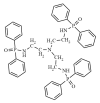Preparation and Mechanism of Toughened and Flame-Retardant Bio-Based Polylactic Acid Composites
- PMID: 36679181
- PMCID: PMC9866757
- DOI: 10.3390/polym15020300
Preparation and Mechanism of Toughened and Flame-Retardant Bio-Based Polylactic Acid Composites
Abstract
As a biodegradable thermoplastic, polylactic acid (PLA) shows great potential to replace petroleum-based plastics. Nevertheless, the flammability and brittleness of PLA seriously limits its use in emerging applications. This work is focused on simultaneously improving the flame-retardancy and toughness of PLA at a low additive load via a simple strategy. The PLA/MKF/NTPA biocomposites were prepared by incorporating alkali-treated, lightweight, renewable kapok fiber (MKF) and high-efficiency, phosphorus-nitrogenous flame retardant (NTPA) into the PLA matrix based on the extrusion-injection molding method. When the additive loads of MKF and NTPA were 0.5 and 3.0 wt%, respectively, the PLA/MKF/NTPA biocomposites (PLA3.0) achieved a rating of UL-94 V-0 with an LOI value of 28.3%, and its impact strength (4.43 kJ·m-2) was improved by 18.8% compared to that of pure PLA. Moreover, the cone calorimetry results confirmed a 9.7% reduction in the average effective heat of combustion (av-EHC) and a 0.5-fold increase in the flame retardancy index (FRI) compared to the neat PLA. NTPA not only exerted a gas-phase flame-retardant role, but also a condensed-phase barrier effect during the combustion process of the PLA/MKF/NTPA biocomposites. Moreover, MKF acted as an energy absorber to enhance the toughness of the PLA/MKF/NTPA biocomposites. This work provides a simple way to prepare PLA biocomposites with excellent flame-retardancy and toughness at a low additive load, which is of great importance for expanding the application range of PLA biocomposites.
Keywords: high-effective flame retardant; mechanism; polylactic acid; toughening.
Conflict of interest statement
The authors declare no conflict of interest.
Figures








Similar articles
-
Construction of carbon-based flame retardant composite with reinforced and toughened property and its application in polylactic acid.RSC Adv. 2022 Aug 10;12(34):22236-22243. doi: 10.1039/d2ra04130h. eCollection 2022 Aug 4. RSC Adv. 2022. PMID: 36043090 Free PMC article.
-
Flame Retardancy and Toughness of Poly(Lactic Acid)/GNR/SiAHP Composites.Polymers (Basel). 2019 Jul 3;11(7):1129. doi: 10.3390/polym11071129. Polymers (Basel). 2019. PMID: 31277216 Free PMC article.
-
A novel bio-based ferric flame retardant effectively improving the flame retardancy and mechanical properties of polylactic acid.Int J Biol Macromol. 2024 Nov;281(Pt 2):136908. doi: 10.1016/j.ijbiomac.2024.136908. Epub 2024 Oct 26. Int J Biol Macromol. 2024. PMID: 39490484
-
Flame Retardant Polypropylenes: A Review.Polymers (Basel). 2020 Jul 29;12(8):1701. doi: 10.3390/polym12081701. Polymers (Basel). 2020. PMID: 32751298 Free PMC article. Review.
-
Flame Retardant Epoxy Composites on the Road of Innovation: An Analysis with Flame Retardancy Index for Future Development.Molecules. 2019 Nov 1;24(21):3964. doi: 10.3390/molecules24213964. Molecules. 2019. PMID: 31683861 Free PMC article. Review.
Cited by
-
Lightweight Natural Fiber Insulation Boards Produced with Kapok Fiber (Ceiba Pentandra) and Polylactic Acid or Bicomponent Fiber as a Binder.Glob Chall. 2025 Jan 27;9(3):2400310. doi: 10.1002/gch2.202400310. eCollection 2025 Mar. Glob Chall. 2025. PMID: 40071220 Free PMC article.
References
-
- Wang X., Wang S., Wang W., Li H., Liu X., Gu X., Bourbigot S., Wang Z., Sun J., Zhang S. The Flammability and Mechanical Properties of Poly (Lactic Acid) Composites Containing Ni-MOF Nanosheets with Polyhydroxy Groups. Compos. Part B Eng. 2020;183:107568. doi: 10.1016/j.compositesb.2019.107568. - DOI
-
- Râpă M., Miteluţ A.C., Tănase E.E., Grosu E., Popescu P., Popa M.E., Rosnes J.T., Sivertsvik M., Darie-Niţă R.N., Vasile C. Influence of Chitosan on Mechanical, Thermal, Barrier and Antimicrobial Properties of PLA-Biocomposites for Food Packaging. Compos. Part B Eng. 2016;102:112–121. doi: 10.1016/j.compositesb.2016.07.016. - DOI
Grants and funding
- 2022YFC3080600/National Key R&D Program of China
- 2572022BU02/Fundamental Research Funds for the Central Universities
- grant nos. 52203082/Natural Science Foundation of China
- GZ20220056/Key Research and Development Projects in Heilongjiang Province
- 202110225445/Undergraduate Innovation Project for Northeast Forestry University
LinkOut - more resources
Full Text Sources
Research Materials

